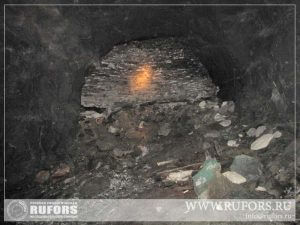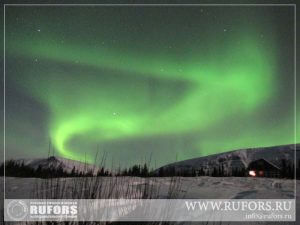
The mysteries of the northern land: Sacred lakes and secrets hidden underground (3.díl): conclusion
 30. 12. 2016
30. 12. 2016

In December 2008, the Russian Ufological Research Station RUFORS made an expedition to the Kola Peninsula. Its basic task was to find traces of the legendary Hyperborea, which, as scientists have cautiously said in recent years, became the place where Russian nationality came from, and which fundamentally influenced the development, science and culture of other countries…
The Mystery of Sacred Lakes
The Sami themselves say that this lake was created by their ancestors and, according to legend, huge greats, the ancestors of the Sami, materialized from it, who then taught them agriculture, cattle breeding and the art of living in harmony with nature in general.
The Sami believe that the Kolan Peninsula is the reference point of the life of all living on earth. Many have heard of the legendary Lapplandii (Czech Lapland, Swedish Lappland, Finnish Lappi, Russian Lapland, Note translation). And it was this peninsula that was called Lappie in the 15th century AD. Isn't that the mysterious Lapplandia, the land of the "descendants" of the legendary Hyperborea? It is quite possible that this is the case. It is not for nothing that the Sami are also called Lopars. This directly confirms that the Sámi lived on this land long before the discoverers of the Kola Peninsula. Medieval geographers wrote that northern Europe is inhabited by monster nations. They had one eye, several hands, and fell asleep like bears. So the question arises: if their description is correct, then practically 80% correctly described the appearance of the deity worshiped by the Sami; does this mean that these beings did exist? From a scientific point of view, this is difficult to answer, but the Sami themselves believe it, and this faith is not based on blind worship, but on the real knowledge they use in daily life. As they say, the gods passed this knowledge on to them in times far away.
Secrets hidden underground
In the Lovozerská tundra on the east bank of the Umbozer (lake name, Umsozero, translation note) finds the so-called Umbozersky mine, in the Umba dialect. After several decades of continuous ore mining, the miners literally came across a vast field of ussingite, which is light purple semi-precious. What's extraordinary? When the miners extracted the ussigit vein and continued drilling, then what appeared before their eyes was simply unimaginable! Behind her was a layer of rock, consisting of seventy-four different minerals! The scientists found themselves in  dead end! From a geological point of view, such an amount of minerals per cubic meter is simply unbelievable! But that's not all. As it turned out, in addition to the seventy-four known minerals, twelve other absolutely unknown compositions were found at this site! In other words - eighty-six minerals per twenty cubic meters, that's just absurd! Miners and geologists have rightly called this place "Jewelry Box".
dead end! From a geological point of view, such an amount of minerals per cubic meter is simply unbelievable! But that's not all. As it turned out, in addition to the seventy-four known minerals, twelve other absolutely unknown compositions were found at this site! In other words - eighty-six minerals per twenty cubic meters, that's just absurd! Miners and geologists have rightly called this place "Jewelry Box".
The RUFORS research group carefully studied the materials of this shaft and descended to a depth of 1,5 kilometers from the surface entrance during the expedition, which is, as the miners themselves explain, a descent to the one hundred and seventy horizon. Each horizon is approximately ten meters high.
What has opened up before the eyes of the RUFORS research group cannot be logically explained. It is as if a huge, mighty creature has dipped a "spoon" into a mountain, mixed all the rocks and added spices from various amounts of strange minerals to the "bowl". But the survey time in "Jewelry Box" was limited for researchers. This was due to the fact that there were also heavy elements among the various rocks, including uranium. The average radiation in the very heart of the mountain where the research took place was five X-rays per hour! The group leader knew that working more than three hours in such conditions would be critically dangerous to health. Therefore, the time allotted for the research was as short and effective as possible. Unfortunately, due to the high radiation, the group failed to explore all the galleries. But they set it as a goal for the future.
Ancient miners said that there were abandoned corridors at the lowest levels, some of which are now solidly walled up. The main cause of the walling of these once working "passages" can be explained by the danger of landslides and collapse. But the miners also said that in several through tunnels, during horizontal drilling, they encountered huge cavities in which the beam of their headlamps was lost. For individual use, their luminosity was sufficient, about twenty thirty meters, but here the opposite sides did not reach at all. The miners threw stones at them and, according to the echo, determined the approximate volume of the space. Their size was enough to accommodate five railroad cars built side by side. However, such cavities are relatively common in mines. However, these aroused reverent fear in the miners, and the native Sámi, who worked here as miners, categorically refused to walk through these tunnels and explore variants for new wells, invoking the retribution of the ancient Gods. One of the miners remembers that as soon as the last layers of ore fell in, warm, slightly humid but not stale air began to blow from the tunnel. And as the miners stared at the dark distance for a long time, they admitted that they literally felt something huge, strong, and powerful looking at them from somewhere, and gradually an inexplicable fear grew in them. The walls of the tunnel were smooth, wavy, as if they had been first worked with jackhammers and then polished with high heat. His artificial origin immediately hit his eyes.
Members of the research group saw several such linings. They were not hermetic because they were built in a hurry with a single one  goal: not to allow anyone to pass through. Once behind such a wall, the miners heard a loud rumble. When they dismantled the wall, they saw that the originally empty cavity was flooded. Well, it happens in the mountains! They strengthened the vault and re-walled it. It's been a few days. Something soon happened in the Umba mine that no one expected in these mountains. About thirty percent of the entire northern face was flooded, killing people! Then the miners began to strike and the shaft gradually fell. Among the miners, there was talk of a curse of ancient noids (shamans) who protected the underground kingdoms of ancient civilizations. Wages were reduced and all miners were fired after the last strike. Some for encouraging other mining groups and shifts to refuse to start work.
goal: not to allow anyone to pass through. Once behind such a wall, the miners heard a loud rumble. When they dismantled the wall, they saw that the originally empty cavity was flooded. Well, it happens in the mountains! They strengthened the vault and re-walled it. It's been a few days. Something soon happened in the Umba mine that no one expected in these mountains. About thirty percent of the entire northern face was flooded, killing people! Then the miners began to strike and the shaft gradually fell. Among the miners, there was talk of a curse of ancient noids (shamans) who protected the underground kingdoms of ancient civilizations. Wages were reduced and all miners were fired after the last strike. Some for encouraging other mining groups and shifts to refuse to start work.
Despite its uniqueness, mining in the Umba mine was terminated and the mine was preserved. We can only speculate whether it is a curse of the old noids, or simply a coincidence. But the curtain of Hyperborei's secrets is opening more and more. Until now, the "Jewelry Box" is unique in that it holds a unique world record in the content of a large amount of minerals concentrated in one place.
To this day, you will not find an analogous place on our planet that is at least a little like it. It is this uniqueness that has attracted the attention of researchers from the RUFORS group. If we start from the hypothesis that Hyperborea actually existed in this area, then the miraculous "Jewelry Box" in the Agvundaschorr mountain range would not seem so unreal, but it would serve as additional and convincing enough evidence that Hyperborea did exist in the Lovozersk tundra!
Summer RUFORS expedition
One of the basic tasks of the summer season is considered by the participants of the Russian Ufological Research Station RUFORS to continue the research of the Kola Peninsula. The materials obtained during the December expedition, as well as a detailed analysis of all available sources about Hyperborea, allow us to make a bold assumption that traces of this civilization must be sought not only on the surface, but also underground and underwater. That is why dives are planned and the search for inputs below the surface will continue in specific places, which was specified after studying all the materials. The slopes of the mountains will also be searched in those places where caves could be preserved. The special facility will make it possible to re-carry out a georadar survey of the underground cavities discovered by the expeditions of Alexander Barchenko and Valeriy Demin.





 1
1